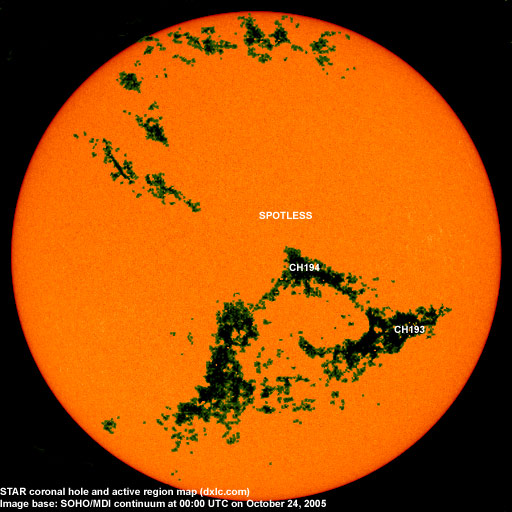

Last major update issued on October 24, 2005 at 02:55 UTC.
[Solar and
geomagnetic data - last month (updated daily)]
[Solar wind and
electron fluence charts (updated daily)]
[Solar cycles 21-23
(last update October 2, 2005)]
[Solar cycles 1-20]
[Graphical comparison
of cycles 21, 22 and 23 (last update October 2, 2005)]
[Graphical
comparison of cycles 2, 10, 13, 17, 20 and 23 (last update October 2,
2005)]
[Historical solar and
geomagnetic data charts 1954-2004 (last update February 1, 2005)]
[Archived reports
(last update October 2, 2005)]
The geomagnetic field was inactive to very quiet on October 23. Solar wind speed ranged between 320 and 370 (all day average 341) km/sec.
Solar flux measured at 20h UTC on 2.8 GHz was 74.2. The planetary
A
index was 2 (STAR Ap - based on the mean of three hour interval ap
indices: 2.0).
Three hour interval K indices: 00001111 (planetary), 10001111 (Boulder).
The background x-ray flux is below the class A1 level.
At midnight the visible solar disk was spotless. The solar flare activity level was very low. No C class events were recorded during the day.
October 21-23: No obvious fully or partly Earth directed CMEs were observed. A full halo CME with an origin on the back side of the sun was observed beginning at 10:24 UTC on October 22.
Coronal hole
history (since late October 2002)
Compare today's report with the situation one solar rotation ago: 28
days ago 27 days ago 26
days ago
A recurrent coronal hole (CH193) in the southern hemisphere was in an Earth facing position on October 20-21. CH193 did not cause any disturbance during the previous rotation. Recurrent trans equatorial coronal hole CH194 was in an Earth facing position on October 22-23.

Processed SOHO/EIT 284 image at 01:06 UTC on October 24. The darkest areas on the solar disk are likely coronal holes.
The geomagnetic field is expected to be quiet on October 24 and quiet to active on October 25-26 due to coronal hole effects.
| Coronal holes (1) | Coronal mass ejections (2) | M and X class flares (3) |
1) Effects from a coronal hole could reach Earth
within the next 5 days. When the high speed stream has arrived
the color changes to green.
2) Material from a CME is likely to impact Earth within 96 hours.
3) There is a possibility of either M or X class flares within the next
48 hours.
Green: 0-20% probability, Yellow: 20-60% probability, Red: 60-100% probability.
Long distance low and medium frequency (below 2 MHz) propagation along east-west paths over high and upper middle latitudes is very good. Propagation on long distance northeast-southwest paths is poor. Trans Atlantic propagation conditions are normally monitored every night on 1470 kHz. Dominant stations tonight: WWNN Boca Raton FL and WLAM Lewiston ME. A large number of US and Canadian stations were heard on other frequencies with some of the east coast stations having very strong signals. 720 and 990 kHz are usually blocked by European stations at my location, tonight CHTN 720 and CKGM 990 were dominating those frequencies.

Compare to the previous day's image.
Data for all numbered solar regions according to the Solar Region Summary provided by NOAA/SEC. Comments are my own, as is the STAR spot count (spots observed at or inside a few hours before midnight) and data for regions not numbered by SEC or where SEC has observed no spots. SEC active region numbers in the table below and in the active region map above are the historic SEC/USAF numbers.
| Active region | Date numbered | SEC spot count |
STAR spot count |
Location at midnight | Area | Classification | Comment |
|---|---|---|---|---|---|---|---|
| 10815 | 2005.10.14 | N07W45 | plage | ||||
| 10816 | 2005.10.19 | S14W81 | plage | ||||
| 10817 | 2005.10.23 | 1 | N04E21 | 0010 | AXX | spotless | |
| S599 | 2005.10.22 | S08E23 | plage | ||||
| Total spot count: | 1 | 0 | |||||
| SSN: | 11 | 0 | |||||
| Month | Average solar flux at Earth |
International sunspot number | Smoothed sunspot number |
|---|---|---|---|
| 2000.04 | 184.2 | 125.5 | 120.8 cycle 23 sunspot max. |
| 2000.07 | 202.3 | 170.1 | 119.8 |
| 2001.12 | 235.1 | 132.2 | 114.6 (-0.9) |
| 2004.08 | 109.6 | 40.9 | 39.2 (-1.0) |
| 2004.09 | 103.1 | 27.7 | 37.5 (-1.7) |
| 2004.10 | 105.9 | 48.0 | 35.9 (-1.6) |
| 2004.11 | 113.2 | 43.5 | 35.3 (-0.6) |
| 2004.12 | 94.5 | 17.9 | 35.2 (-0.1) |
| 2005.01 | 102.2 | 31.3 | 34.6 (-0.6) |
| 2005.02 | 97.2 | 29.2 | 33.9 (-0.7) |
| 2005.03 | 89.9 | 24.5 | 33.5 (-0.4) |
| 2005.04 | 86.0 | 24.4 | (31.9 predicted, -1.6) |
| 2005.05 | 99.3 | 42.6 | (29.4 predicted, -2.5) |
| 2005.06 | 93.7 | 39.6 | (28.1 predicted, -1.3) |
| 2005.07 | 96.4 | 39.9 | (26.9 predicted, -1.2) |
| 2005.08 | 90.5 | 36.4 | (25.0 predicted, -1.9) |
| 2005.09 | 91.1 | 22.1 | (23.0 predicted, -2.0) |
| 2005.10 | 78.1 (1) | 11.2 (2) | (21.0 predicted, -2.0) |
1) Running average based on the daily 20:00 UTC observed solar flux
value at 2800 MHz.
2) Unofficial, accumulated value based on the Boulder (NOAA/SEC)
sunspot number. The official international sunspot number is typically
30-50% lower.
This report has been prepared by Jan Alvestad. It is based partly on my own observations and analysis, and partly on data from some of these solar data sources. All time references are to the UTC day. Comments and suggestions are always welcome.
| [DX-Listeners' Club] |